Nationally Designated Important Cultural Property
Arakawa Residence Visit
Apr. May Jun. Jul. Aug. Sep. Oct. Nov. Dec. 2021 Inf.
November
November 27th: Snow scene
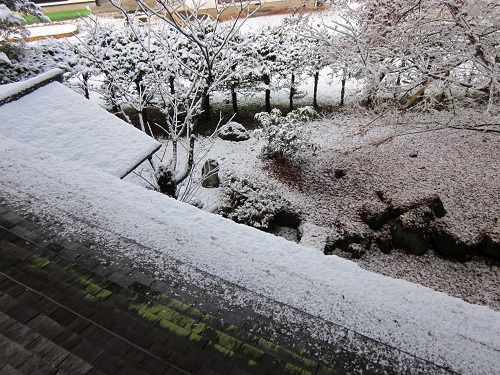 This is a snow scene of the garden seen from the second floor.
(The first snow has fallen.)
This is a snow scene of the garden seen from the second floor.
(The first snow has fallen.)
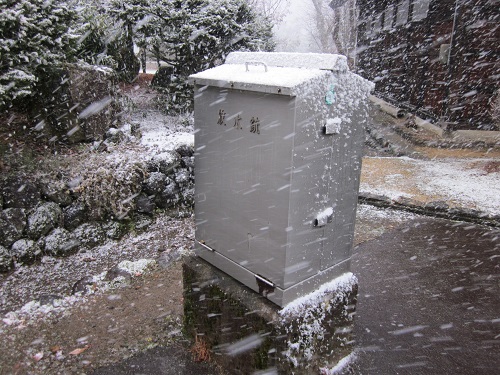 This is a water cannon installed to prevent the spread of fire
from surrounding fires.
This is a water cannon installed to prevent the spread of fire
from surrounding fires.
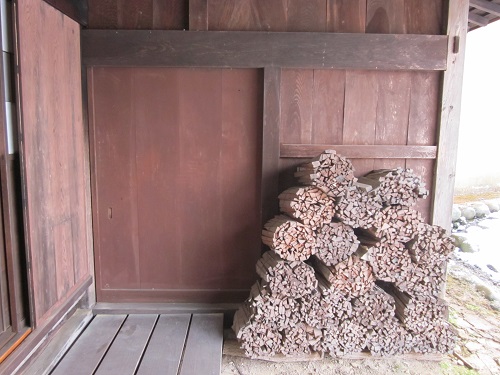 This is a pickle room where they can put pickle tubs.
This is a pickle room where they can put pickle tubs.
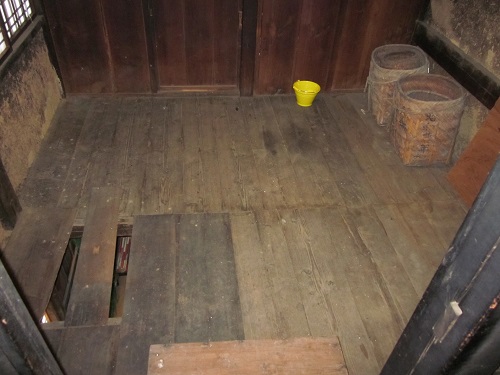 The upstairs room above the Mayanodoji has a square hole in the floor.
They used pulley to raise the mulberry leaves through this hole from
the first floor to the second floor.
The upstairs room above the Mayanodoji has a square hole in the floor.
They used pulley to raise the mulberry leaves through this hole from
the first floor to the second floor.
November 27th: Juzu (rosary)
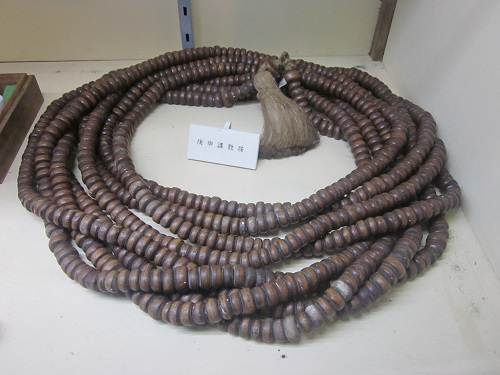 this is a Juzu (rosary) of Koshinkou.
this is a Juzu (rosary) of Koshinkou.
In the Koshinkou, people gathered at the house in charge of each ward
on the night of the Kanoesaru in the Eto (zodiac).
While holding a large Juzu (rosary) with a diameter of 4 or 5 meters,
they turned the Juzu to the chant.
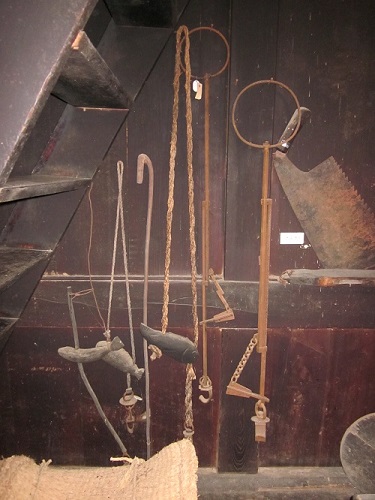 These are Kagizuru (pothook) that are hung above the Irori (hearth).
These are Kagizuru (pothook) that are hung above the Irori (hearth).
Carvings of Kagizuru (pothook) are carved with carp, sea bream, fans,
and other auspicious objects.
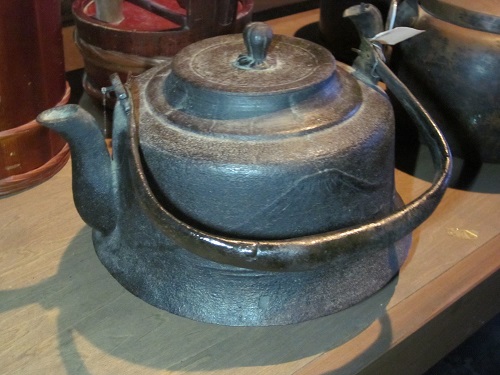 This is a cast iron kettle (Tetsubin) used to boil hot water.
This is a cast iron kettle (Tetsubin) used to boil hot water.
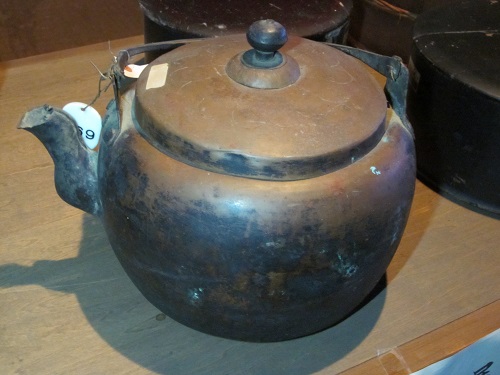 This is a kettle (Yakan) made of copper for boiling water.
This is a kettle (Yakan) made of copper for boiling water.
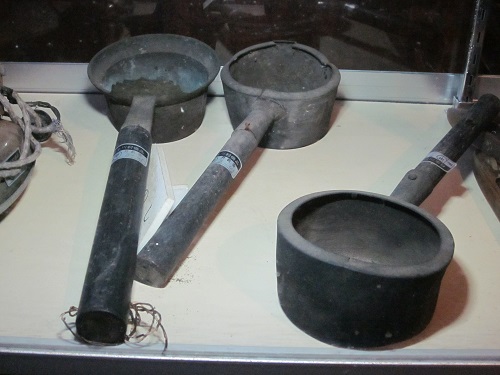 These are Hinoshi (Iron) to smooth out the wrinkles of the cloth.
These are Hinoshi (Iron) to smooth out the wrinkles of the cloth.
They put charcoal fire in a metal bowl with a smooth bottom
and used it by hitting the hot bottom against the cloth.
November 27th: Old documents
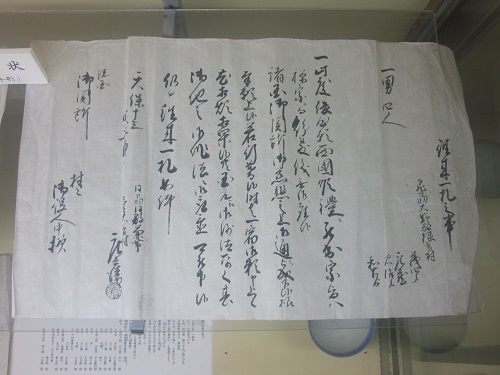 There are many old documents on display in the storehouse (Dozo) and Oue.
There are many old documents on display in the storehouse (Dozo) and Oue.
This is an old document of a traffic letter (passage bill).
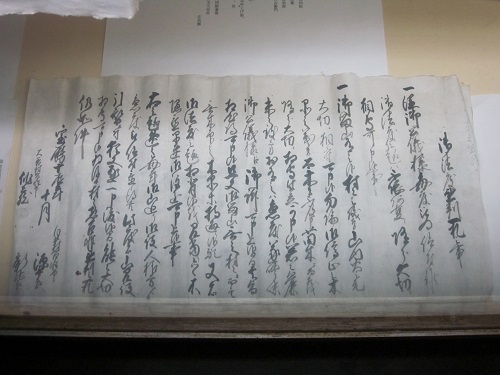 This is an old document of the Genroku Kenchi Mizucho (land register) copy.
This is an old document of the Genroku Kenchi Mizucho (land register) copy.
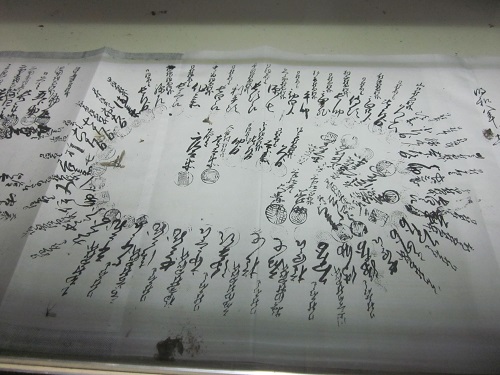 This is an old document of Meiwa Disturbance Umbrella Type Conjunction Letter.
This is an old document of Meiwa Disturbance Umbrella Type Conjunction Letter.
November 27th: photographs
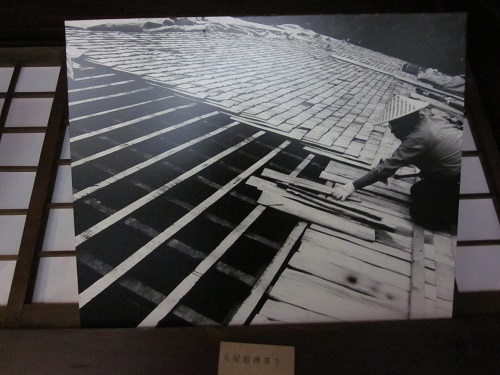 There are many photographs on the Oue.
There are many photographs on the Oue.
This is a photograph of a large roof was making of wooden boards (Kure).
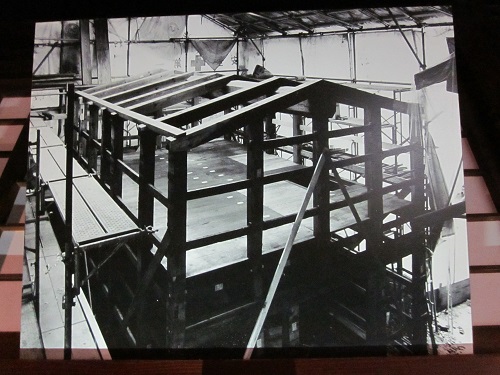 This is a photograph of the Storehouse (Dozo) framework before repair.
This is a photograph of the Storehouse (Dozo) framework before repair.
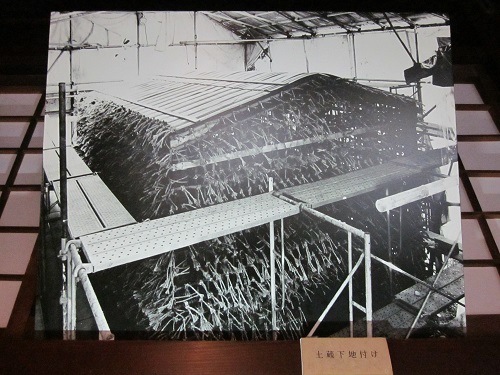 This is a photograph of attaching the groundwork to the Storehouse (Dozo).
This is a photograph of attaching the groundwork to the Storehouse (Dozo).
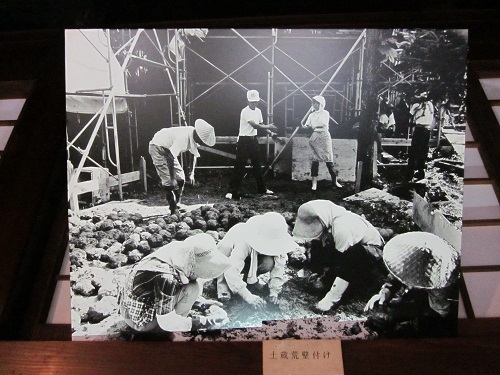 This is a photograph of attaching a rough wall to the Storehouse (Dozo).
This is a photograph of attaching a rough wall to the Storehouse (Dozo).
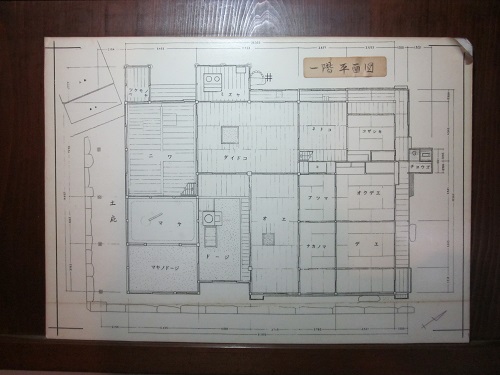 This is the floor plan view of the first floor.
This is the floor plan view of the first floor.
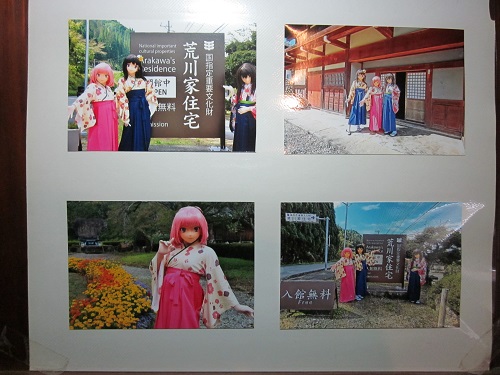 These are photographs of cosplays.
These are photographs of cosplays.
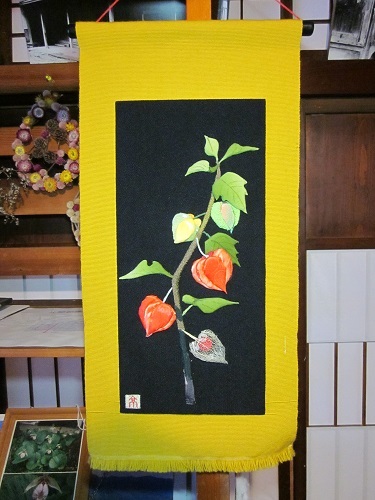 A handicraft work is decorated.
A handicraft work is decorated.
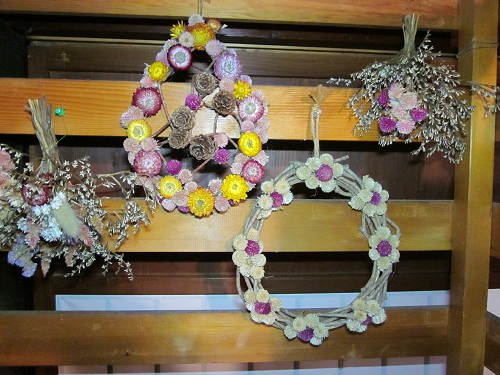 Handmade wreaths are decorated.
Handmade wreaths are decorated.
November 18th: Tsuchibina
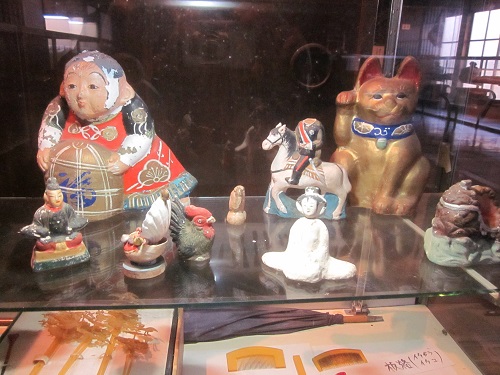 These are clay dolls (Tsuchibina) that has been baked clay
and given color and pattern.
These are clay dolls (Tsuchibina) that has been baked clay
and given color and pattern.
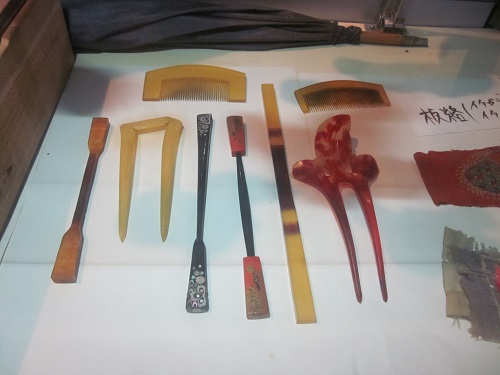 These are combs and Kougai (hairpin) for tying hair.
These are combs and Kougai (hairpin) for tying hair.
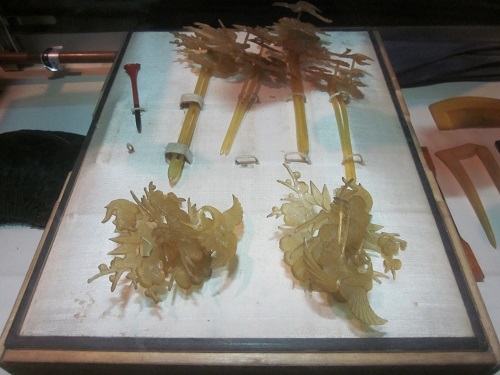 These are Kanzashi (ornamental hairpin) used for hair ornaments.
These are Kanzashi (ornamental hairpin) used for hair ornaments.
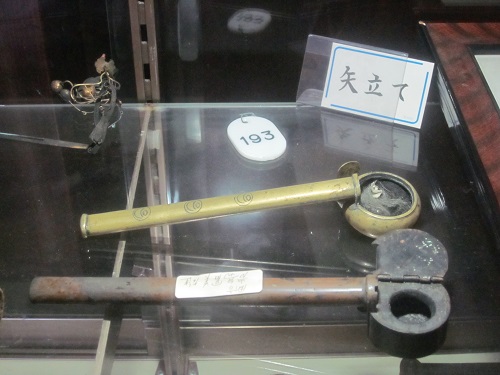 These are portable writing utensil Yatate that combines a brush and an ink urn.
These are portable writing utensil Yatate that combines a brush and an ink urn.
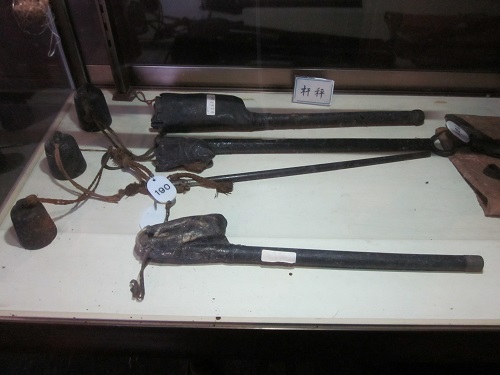 These are beam balance (Saobakari) that weigh.
These are beam balance (Saobakari) that weigh.
November 18th: Second Floor
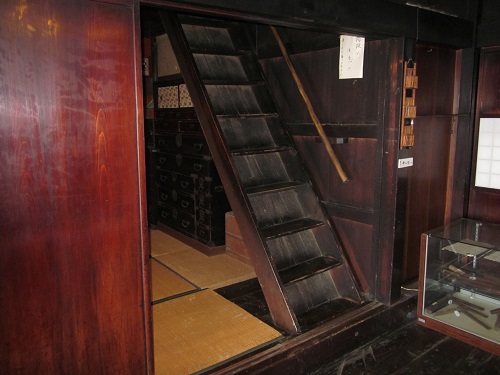 This is the staircase that goes up to the second floor.
This is the staircase that goes up to the second floor.
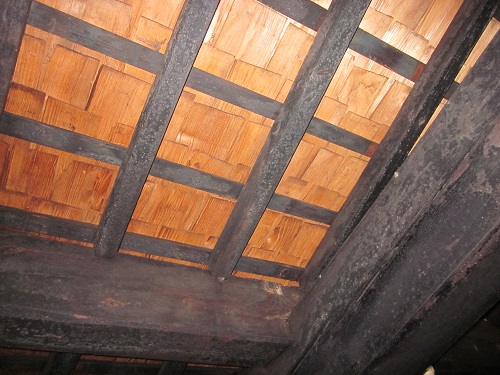 This is the attic on the second floor.You can see the wooden board of the roof.
This is the attic on the second floor.You can see the wooden board of the roof.
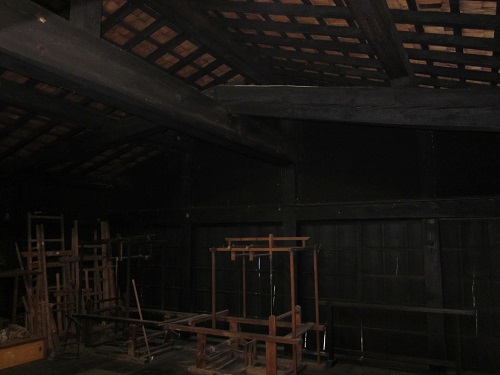 The second floor has a large attic space.
Sericulture was practiced here.
The second floor has a large attic space.
Sericulture was practiced here.
The smoke from the hearth (Irori) on the first floor rises from the slatted wood
ceiling to the second floor, and the smoke blackens the pillars, beams,
girders, walls, etc., and has an antiseptic and insect repellent effects.
 On the second floor, you can put a lot of large sericulture racks
and mulberry leaves for sericulture.
In addition, there are not many pillars and walls other than the ridge street
so that it is easy to work.
On the second floor, you can put a lot of large sericulture racks
and mulberry leaves for sericulture.
In addition, there are not many pillars and walls other than the ridge street
so that it is easy to work.
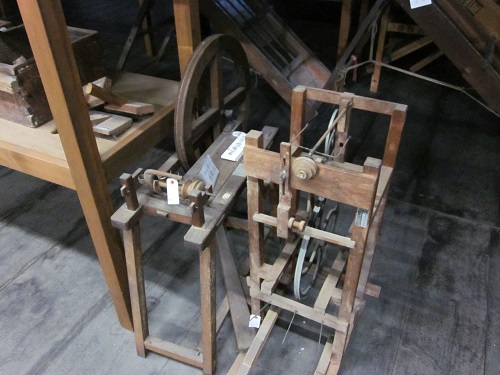 These are yarn spinning and reeling machines.
These are yarn spinning and reeling machines.
They sheared the wool of sheep raised by farmers and made yarn from the wool.
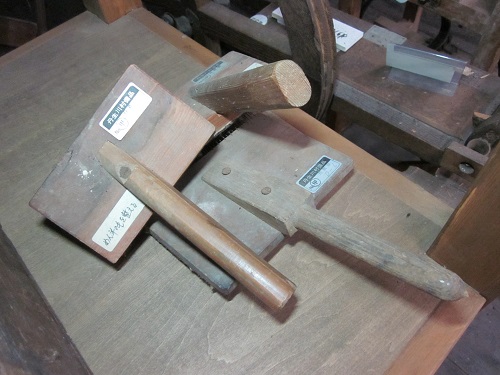 These are fluffing machines that prepares the wool of sheep.
These are fluffing machines that prepares the wool of sheep.
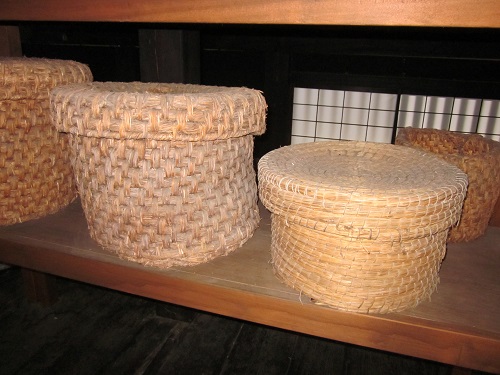 This is a straw container to keep the rice warm.
This is a straw container to keep the rice warm.
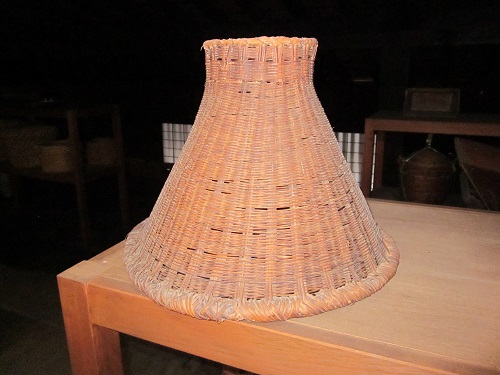 This is a traw bag funnel used when putting rice in a traw bag.
This is a traw bag funnel used when putting rice in a traw bag.
November 18th: Kamidana (household Shinto altar)
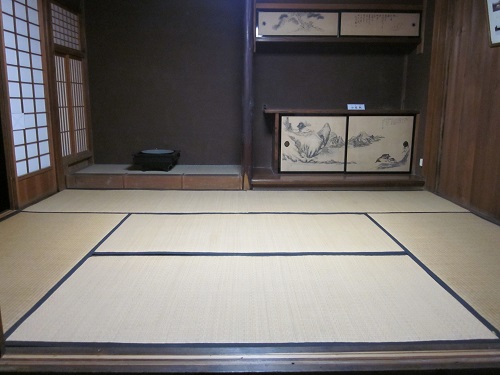 This is a kozashiki (small tatami room) on the back side of the Dee.
This is a kozashiki (small tatami room) on the back side of the Dee.
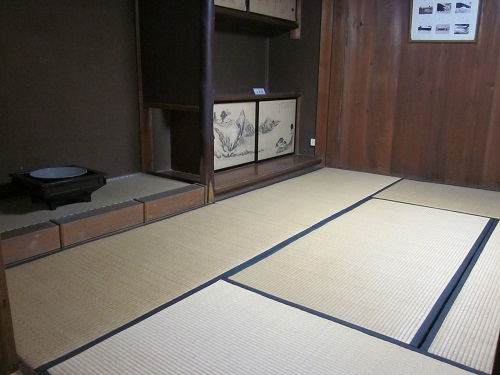 This is a kozashiki (small tatami room) seen from the garden side.
This is a kozashiki (small tatami room) seen from the garden side.
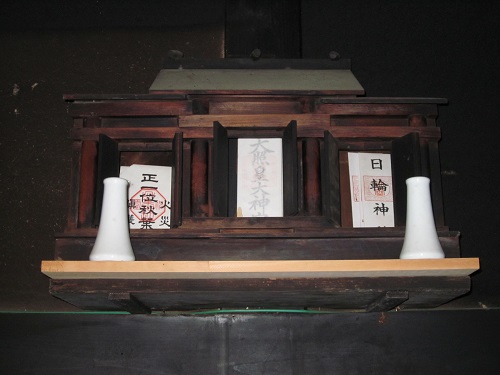 Kamidana (household Shinto altar) is enshrined on the upper side
of Daidoko's Kamoi (lintel).
Kamidana (household Shinto altar) is enshrined on the upper side
of Daidoko's Kamoi (lintel).
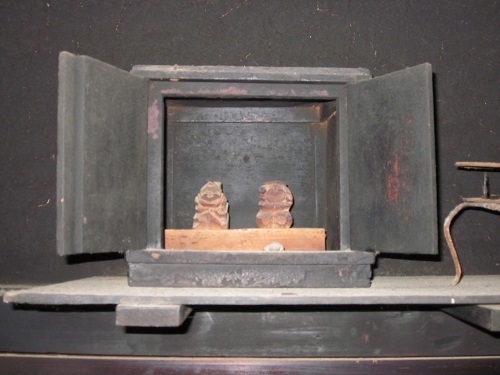 Ebisu and Daikoku are enshrined on the upper side of Kamoi (lintel).
Ebisu and Daikoku are enshrined on the upper side of Kamoi (lintel).
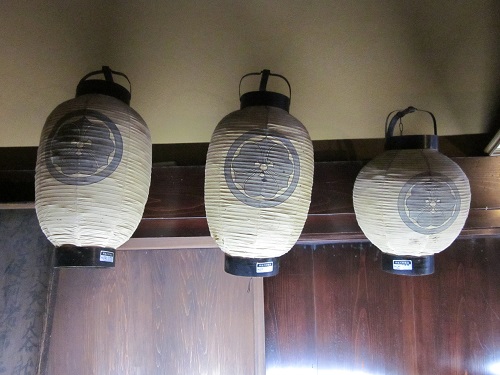 These are lJapanese lanterns hanging on Kamoi (lintel) of Oe.
These are lJapanese lanterns hanging on Kamoi (lintel) of Oe.
November 18th: Toilet
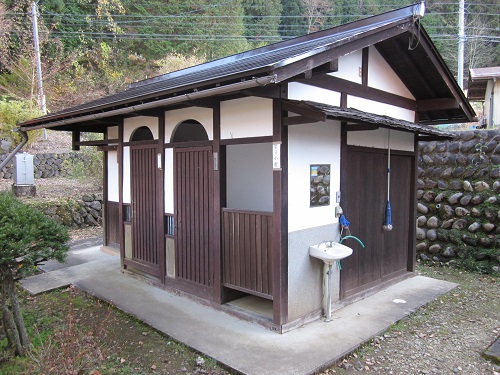 This is a toilet in a separate building.There was a bath in the back.
This is a toilet in a separate building.There was a bath in the back.
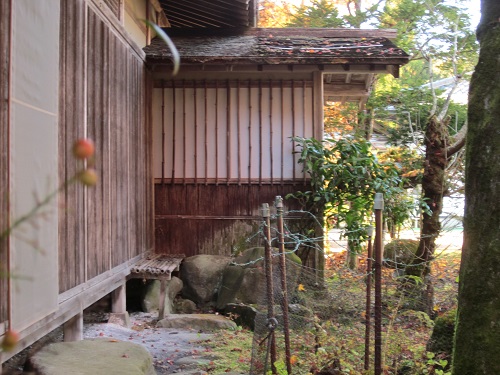 This is Kamisenchi of the toilet used by guest.
This is Kamisenchi of the toilet used by guest.
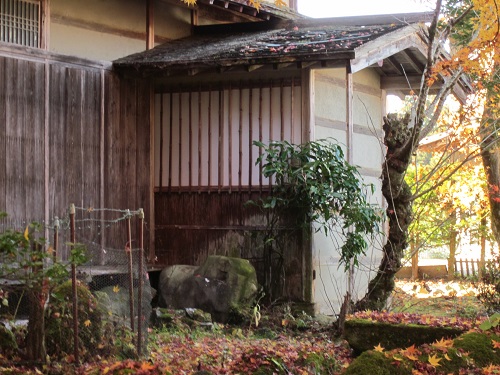 This is Kamisenchi (toilet) seen from the garden.
This is Kamisenchi (toilet) seen from the garden.
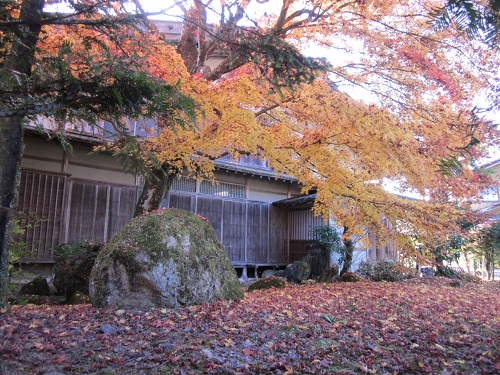 This is the right side of the main house seen from the garden.
This is the right side of the main house seen from the garden.
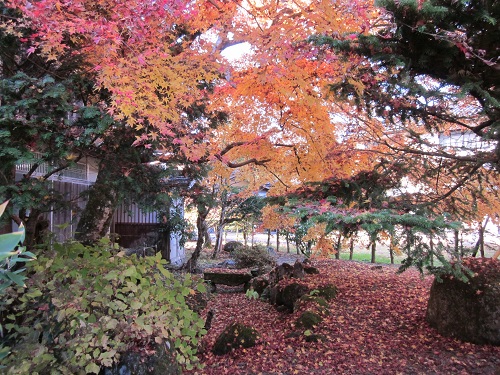 This is the garden on the right side of the main house.
This is the garden on the right side of the main house.
The maples were beautifully autumn leaves.
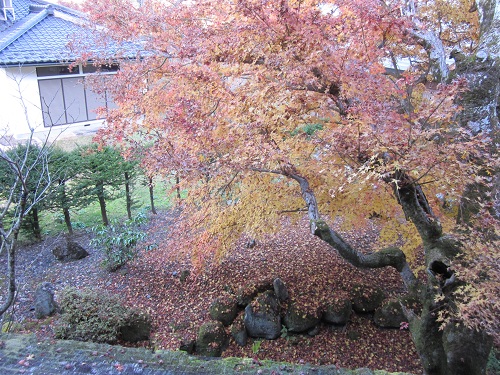 This is the garden seen from the second floor. The maples were autumn leaves.
This is the garden seen from the second floor. The maples were autumn leaves.
November 18th: Cupboard
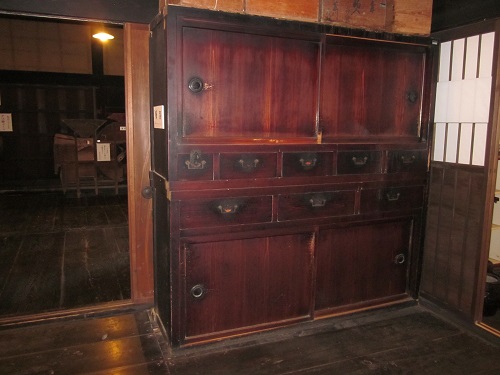 This is a cupboard for rice bowls, bowls, plates, etc.
This is a cupboard for rice bowls, bowls, plates, etc.
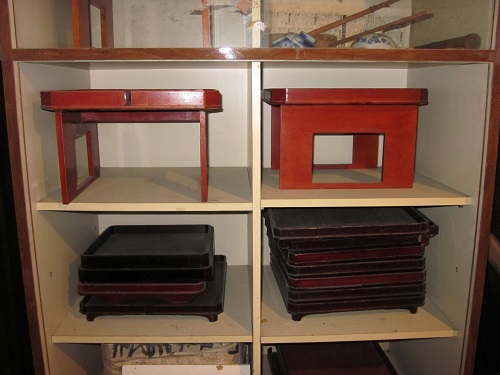 These are square Zen (small dining tables).
These are square Zen (small dining tables).
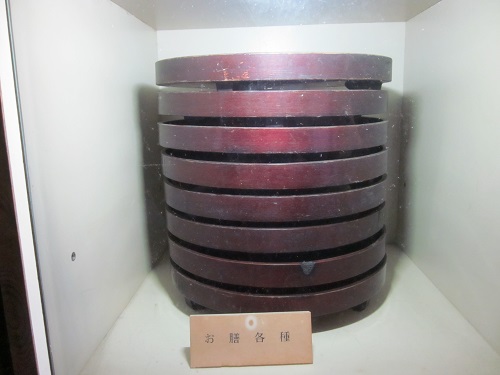 These are circular Zen (small dining table)
These are circular Zen (small dining table)
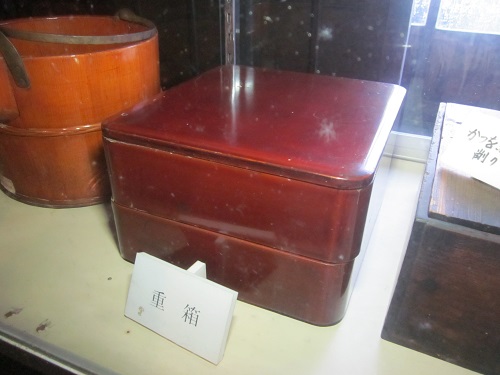 This is a Jubako (nest of boxes) to put food.
This is a Jubako (nest of boxes) to put food.
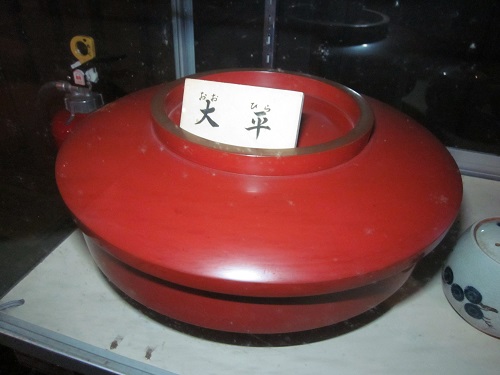 This is a Ohira that serves boiled food.
This is a Ohira that serves boiled food.
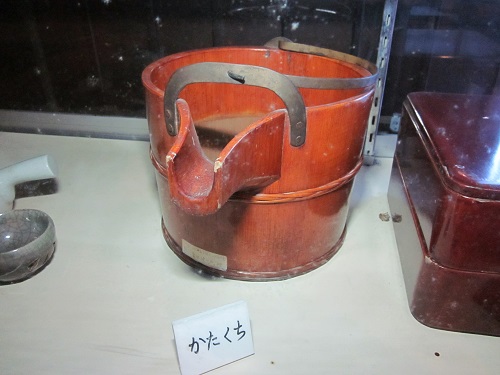 This is a Katakuchi (lipped bowl).
This is a Katakuchi (lipped bowl).
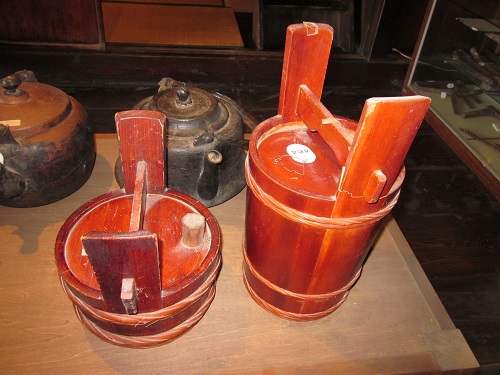 This is a lacquered Tsunodaru (two-handled keg).
This is a lacquered Tsunodaru (two-handled keg).
November 5th: Autumn Leaves
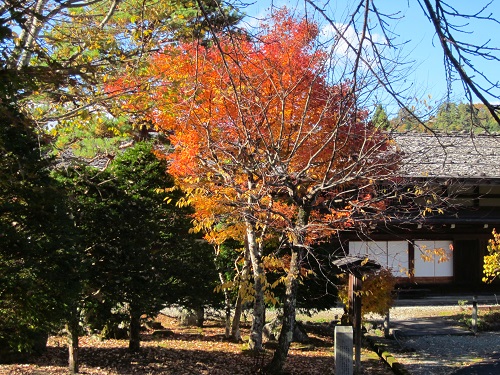 The trees in front of the Arakawa Residence were autumn leaves.
The trees in front of the Arakawa Residence were autumn leaves.
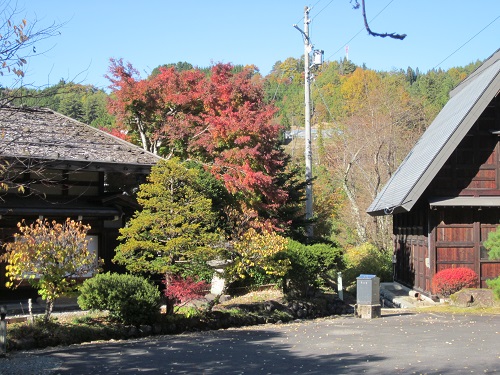 The garden trees on the right side of the Arakawa Residence were autumn leaves.
The garden trees on the right side of the Arakawa Residence were autumn leaves.
November 5th: Doji
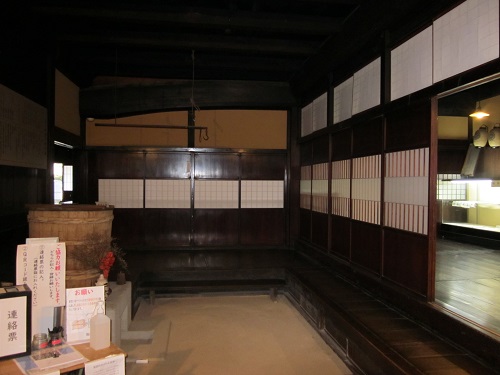 This is Doji (earthen floor) in the place where I entered from the entrance door.
This is Doji (earthen floor) in the place where I entered from the entrance door.
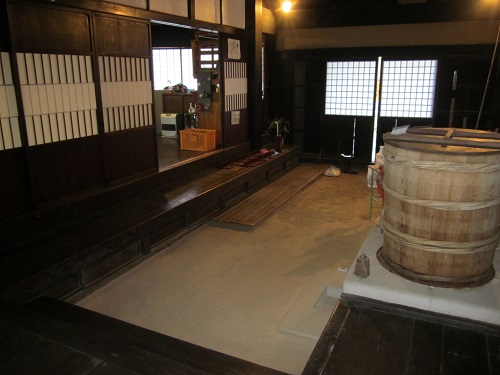 This is Doji seen from the back. There is the entrance door over there.
This is Doji seen from the back. There is the entrance door over there.
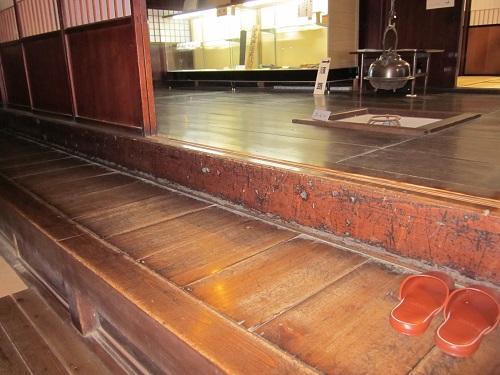 There is a one-step low wooden floor Shikidai in front of the wooden floor Oe.
There is a one-step low wooden floor Shikidai in front of the wooden floor Oe.
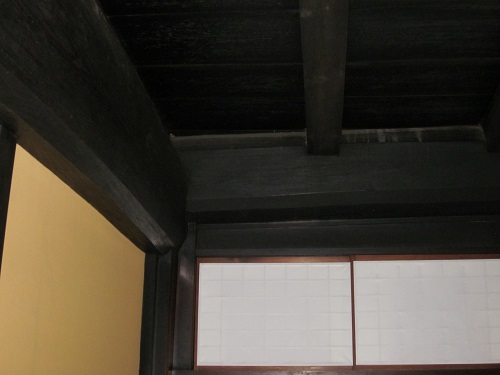 At the top of the Doji are the rather thick beams and girders
that support the weight of the second floor.
At the top of the Doji are the rather thick beams and girders
that support the weight of the second floor.
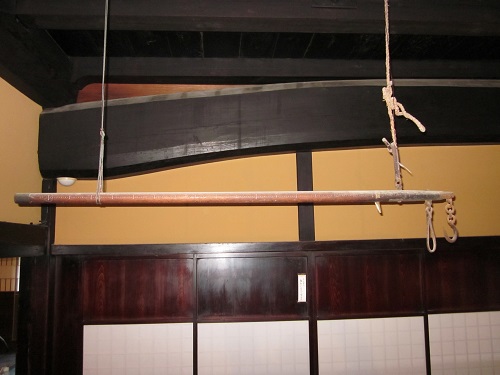 At the back of the Doji hang a beam balance (Saobakari) that weigh.
At the back of the Doji hang a beam balance (Saobakari) that weigh.
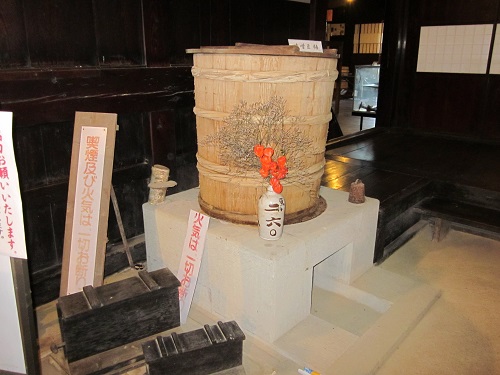 On the left side of the Doji is a Cooking Stove (Kamado).
On the left side of the Doji is a Cooking Stove (Kamado).
A miso bean tub is placed on top of it.
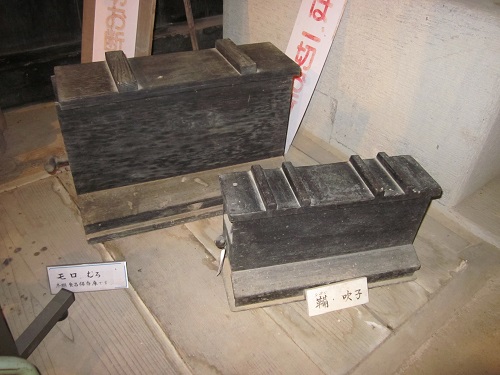 These are bellows (Fuigo) of the blower to increase the heat used for metal
smelting.
These are bellows (Fuigo) of the blower to increase the heat used for metal
smelting.
Inside the board under the bellows (Fuigo), there is a Moro for preserving
winter food.
November 5th: Spear (Yari)
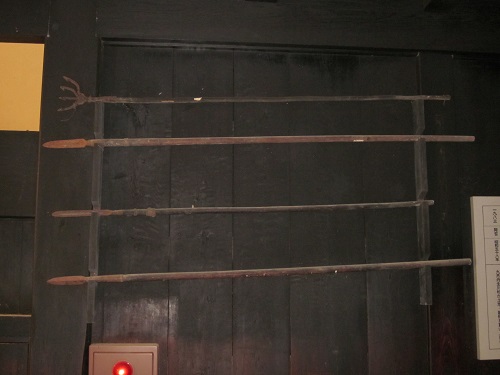 These are weapon spear (Yari) with an elongated blade attached
to the tip of a long handle.
These are weapon spear (Yari) with an elongated blade attached
to the tip of a long handle.
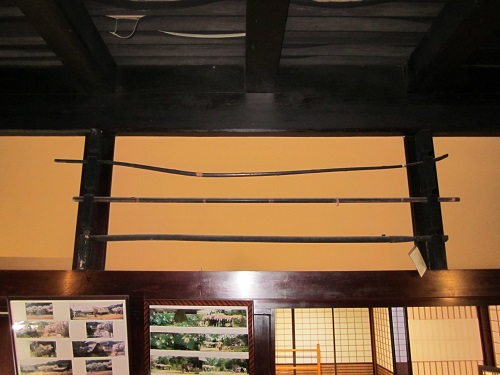 These are the handle of a spear and a bow.
These are the handle of a spear and a bow.
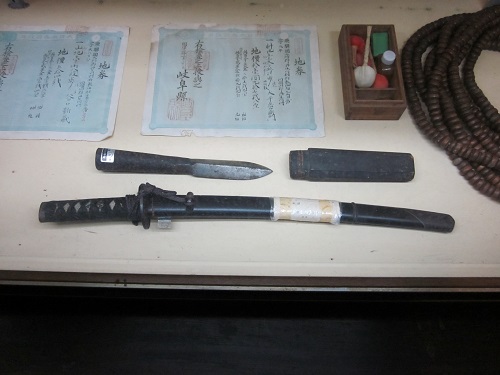 These are the tip of a spear and a sword.
These are the tip of a spear and a sword.
November 5th: Small dining table (Zen)
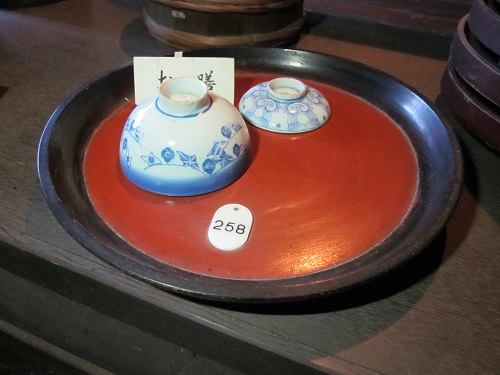 This is a personal small dining table (Zen) to keep a bowl or chopsticks.
This is a personal small dining table (Zen) to keep a bowl or chopsticks.
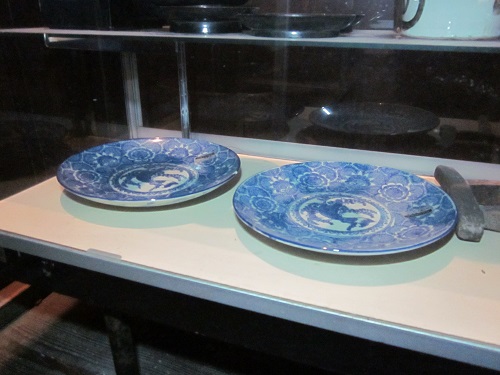 These are dishes to put food on.
These are dishes to put food on.
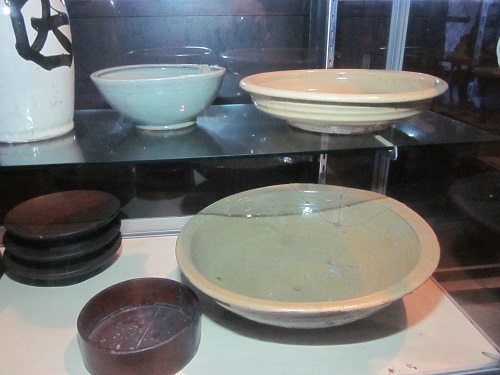 This is a Kabutobachi that kneads rice flour in a bowl when making dumplings.
This is a Kabutobachi that kneads rice flour in a bowl when making dumplings.
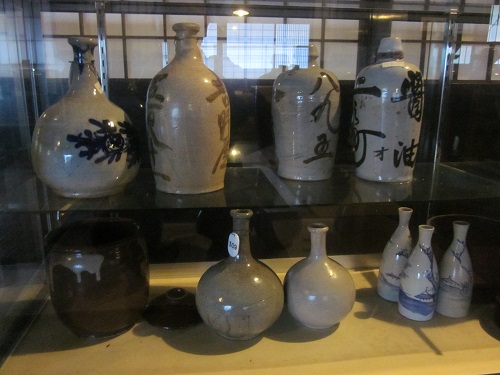 These are Tokkuri (sake bottle) to put soy sauce, sake, etc.
These are Tokkuri (sake bottle) to put soy sauce, sake, etc.
November 5th: Chest of drawers (Tansu)
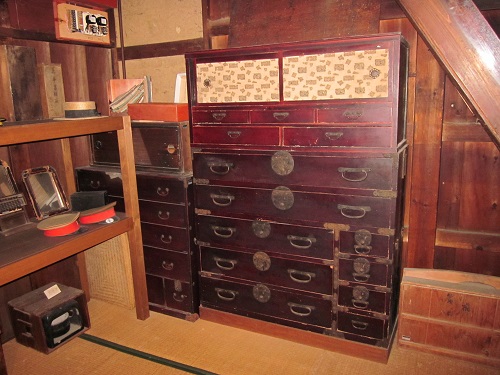 This is a chest of drawers (Tansu) for storing kimonos.
This is a chest of drawers (Tansu) for storing kimonos.
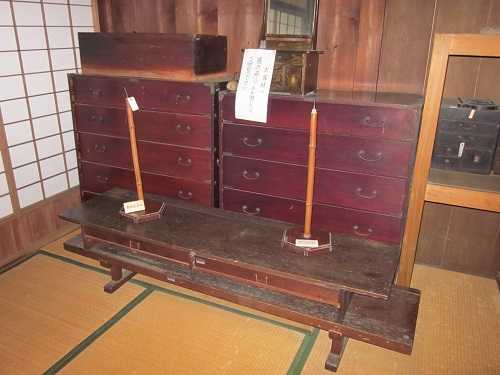 These are sewing tables (Tachinui dai) for cutting and sewing cloth.
These are sewing tables (Tachinui dai) for cutting and sewing cloth.
Candle holders are standing on the sewing tables.
In the back are chest of drawers (Tansu).
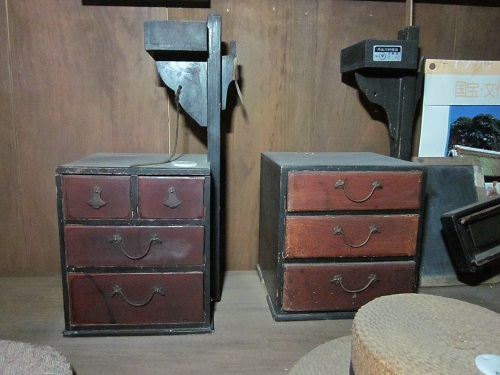 These are sewing box (Haribako) for storing sewing tools.
These are sewing box (Haribako) for storing sewing tools.
Back
<< Home < Back Next >